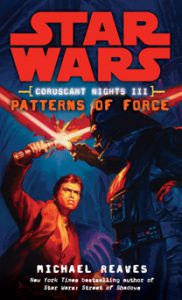Following two solid lead-ins, “Patterns of Force” (2009) is a satisfying final chapter in Michael Reaves’ “Coruscant Nights” trilogy. It’s definitely pulpy (mostly in a good way) and it gets bizarrely untethered at times, but Reaves provides lots of juicy writing about core “Star Wars” concepts in a book that is perhaps used as source material for Disney’s “Rebels” more than any other.
Inquisitors, before they went mainstream in Seasons 1 and 2 of “Rebels,” had a long but mostly understated history in the Expanded Universe. These dark-side adepts who work for Palpatine and Vader were first mentioned in Brian Daley’s “Star Wars” radio drama (1981), but they didn’t make an appearance until the “Young Jedi Knights” books in the 1990s. “Patterns of Force” is the richest exploration of Inquisitors, with Probus Tesla being a primary antagonist to Jax Pavan and company, and more importantly, with Kajin Savaros’ arc providing an example of how the Empire recruits Inquisitors.
Almost out of nowhere, Kaj (perhaps an inspiration for “Rebels’ ” Ezra, with Jax being the answer to Kanan, and Laranth the answer to Hera) pops up as a young Force user in the bowels of Coruscant. Tesla’s appearance raises an old “Star Wars” question: If the Jedi are being wiped out, where is the Empire finding all these Force users? The answer, in retrospect, is obvious: They aren’t killing all the young-Jedi-in-hiding. They are recruiting those with dark-side leanings to be Inquisitors.
At one point, Kaj disintegrates an Inquisitor with his mind, perhaps the most blatant example of an EU author making their character too powerful in the Force. Not even the Emperor could do this. I don’t think even late-EU Luke Skywalker had such power.
While that’s an example of over-the-top writing, the revelation of Vader’s ultimate goal in this trilogy falls into the category of pulp. Bringing together elements from all five Reaves books before this on the timeline, Vader wants the Sith holocron (“Darth Maul: Shadow Hunter”), the bota (the “MedStar” duology) and the pyronium nugget (this trilogy). By insane coincidence, when brought together, they’ll make him even more powerful.
Still, I do enjoy when things are tied together, so much so that I even look for connections that probably weren’t intended. When Whiplash, Coruscant’s Underground Mag-Lev (“Star Wars”-ese for Underground Railroad), intends to smuggle a young Togruta female off the planet, I imagined that this could be Ahsoka, who is posing as an innocent youngster on a mission to Coruscant during her time as a fledgling Rebel after “The Clone Wars.” (Indeed, one of the canceled “Clone Wars” plots would have found Ahsoka back on Coruscant. And Reaves actually did know about Ahsoka at the time of this writing, as “The Clone Wars” debuted around the same time. He probably didn’t intend a tie-in, but I like to think he was perhaps planting seeds for a tale down the road.)
And while Reaves goes too far with Kaj’s powers, the author earns one neat trait for his main character: Jax had been established from the first book, “Jedi Twilight,” as being able to see people by their Force signatures. As such, this allows him to see the similarity between Anakin and Vader, and to suspect that they are one and the same. With this knowledge, Jax joins a rare group (along with Palpatine, Tarkin, Obi-Wan and Yoda) of people who know (or in the case of Jax and Tarkin, strongly suspect, without proof) that Vader is Anakin.

Although “Patterns of Force” has almost as much talk as action, I enjoyed most of the prose because it’s so character-centered. Jax’s group pontificates about assassinating Palpatine all day – and indeed, they never actually get a chance (the closest they get is seeing a hologram of the Emperor) – but the mere discussions are compelling because there’s so much at stake and some of their plans are pretty smart, including using a droid, I-Five.
Only because I-Five shows Force sensitivity (something to be explored further in the de facto fourth “Coruscant Nights” book, 2013’s “The Last Jedi”) do our heroes reject the plan, thinking that the Emperor would sense a Force user. While the idea of a Force-sensitive droid is perhaps silly (indeed, the concept was delivered as a joke in “Star Wars Tales’ ” “Skippy the Jedi Droid”), I do like Reaves’ passage about one way I-Five is different from organic sentients: Time doesn’t heal his emotional wounds, because his memories don’t fade.
I also like how Reaves turns what seemed at the time to be a downer of a Jax-Laranth scene at the end of “Street of Shadows,” where he says he’s not romantically interested, into a key thread of “Patterns of Force.” It turns out Jax was manipulated by the third member of the love triangle, the Zeltron pheromone-user Dejah. Rhinann’s desire to tap into the Force via the bota is also intriguing. And with all the possible moles within Jax’s circle – from Vader’s former assistant Rhinann to street-pounding Zabrak cop Pol Haus — I was genuinely surprised by the revelation.
Better editing and more emphasis on the noir elements could’ve made “Coruscant Nights” into a masterpiece, but still, the trilogy stands as an engaging piece of GFFA pulp. Reaves explores secret Jedi who live in the shadows and makes sure to leave Vader (and certainly the Emperor) as a mostly ephemeral threat (another “Rebels” parallel), yet these books also deliver the full complement of “Star Wars” themes and some tasty bits of EU continuity, from the appearances of Prince Xizor, Captain Typho and Aurra Sing earlier in the series to the tie-ins with Reaves’ own catalog here.

